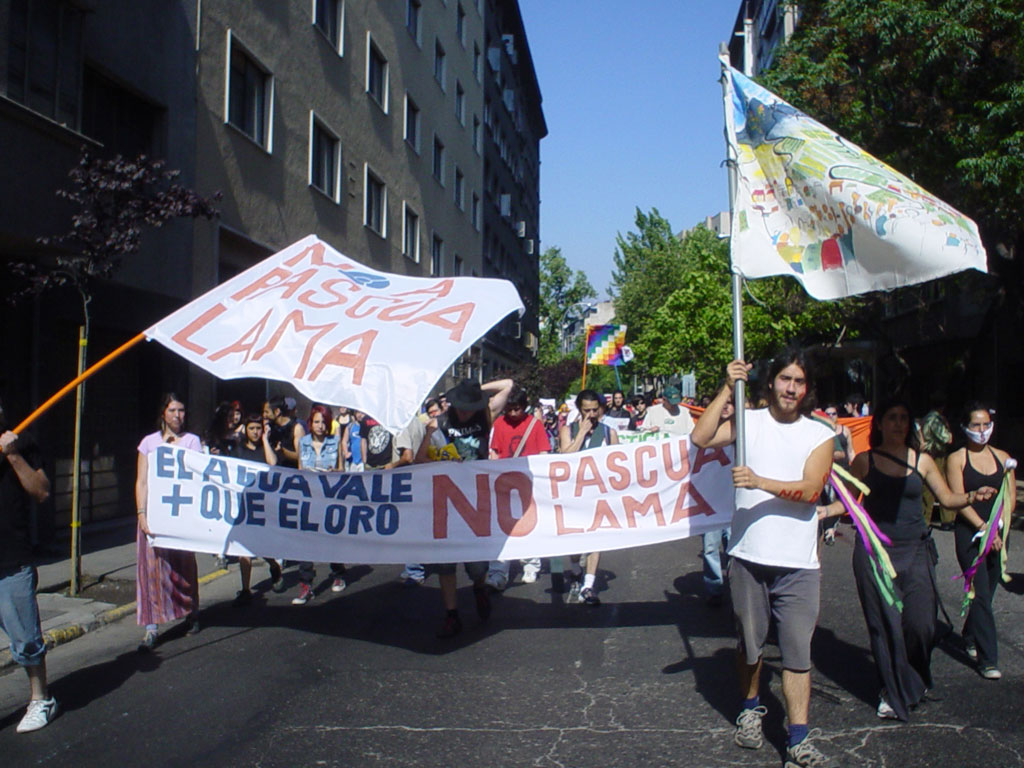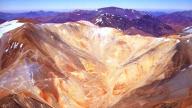Community groups on both side of the Argentina-Chile border are increasing their opposition to Barrick Gold’s proposed Pascua Lama project in Chile, while criticism of its Veladero project already under way on the Argentinean side of the border is also mounting. There have been protests in both countries and even a blockade on the Argentinean side.
Environmental Assessment Delayed Again
On December 5, 2005, the Chilean National Environmental Commission (CONAMA) extended the deadline for review of Barrick’s Environmental Impact Statement (EIS) for the Pascua Lama project to February 16, 2006. The regional environmental commission, COREMA, must review additional information filed by Barrick and submit a summary of its findings to CONAMA for a final decision. Barrick submitted the EIS on December 9, 2004, but has repeatedly asked for the 120-working-day deadline to be suspended to allow it time to respond to COREMA’s questions. If COREMA has further questions after reviewing Barrick’s recently-filed second addendum, the company could ask to suspend the process again. See the actual files at http://www.e-seia.cl/seia-web/ficha/fichaPrincipal.php?id_expediente=1048260.
Long-standing Opposition
The Pascua Lama project has been categorically opposed by a broad cross-section of environmental groups in Chile as well as by many of the 70,000 irrigation farmers and small farmers whose livelihoods depend on the water originating in the glaciers at the mine site.
Barrick had been working on the project since 1996, pushing for a “mining integration and complementation treaty” between Chile and Argentina that would make the project more lucrative by exempting it – and any other mines in the “border zone” sacrifice area along the spine of the Andes – from all tariffs and taxes, streamlining the acquisition of mineral rights, and allowing free transport of goods and material (including ore and wastes) across the border. The treaty was signed in December 1997, and in 1999 a “complementary protocol” was signed setting out the area covered by the treaty and allowing mining companied free access to water resources within the zone. Minera Nevada, Barrick’s Chilean subsidiary, submitted the first EIS in 2000, neglecting to mention the three glaciers standing in the way of the projected open pit mine.
The EIS had already been approved before the farmers of Huasco Valley discovered the details of what was being proposed, and they were alarmed by environmental and social risks posed by the project. The project was put on ice for four years due to low gold prices. When the project was resubmitted in 2004, the farmers began to organize against it, supported by church groups and environmental organisations, and backed by affected groups on the Argentinean side of the border – residents of the towns of Calingasta and Iglesia, as well as the wine producers in the province of San Juan.
According to its latest information, Barrick is still planning to build an open pit mine, breaking up and moving the Esperanza and Toro 1 and 2 glaciers (or “ice reserves” as the company calls them to avoid acknowledging that they are glaciers). The only difference is that they will leave the Guanaco glacier, 2 kilometres to the south, alone rather than dumping the pieces of the other “ice reserves” on top of it.
Protesters Attacked by Police
A letter asking for the cancellation of the Pascua Lama project – with over 18,000 signatures – was presented to the President of Chile on November 11, 2005 but was met with police violence. Police charged protesters when they tried to place chunks of ice, representing the glaciers that the project will destroy, in the Plaza de la Constitución in front of the La Moneda government palace (see below for the text of the letter in English and Spanish). More demonstrations were held in Vallenar and Santiago on November 12.
“Compensation” Deal Challenged
In July, Barrick signed a “protocol agreement” with the Huasco Valley Monitoring Committee, representing irrigation farmers in the area. The agreement committed the farmers to bring their concerns about environmental issues like acid mine drainage and the effects of relocating glaciers before a technical committee the company would set up, rather than submitting their questions to the environmental assessment process – effectively promising to withdraw from participation in the public process. In return, Barrick agreed to fund projects worth $60 million – $3 million a year over the projected 20-year life of the mine – if the project is actually approved. The money would go to improve water supply, quality, and usage. Committee board member Mauricio Perelló is supported by a large group of Committee members in opposing the agreement, which was approved without ratification by the membership.
The agreement has come under fire from many quarters for putting undue pressure on authorities to approve the project. Its critics included “the head of CONAMA”, according to a November 17 report from BNamericas. However, the previous day when MiningWatch Canada’s Jamie Kneen asked Paulina Saball, Executive Director of CONAMA, whether the “protocol” undermines the environmental assessment process by removing key stakeholders from it, she replied that it is an agreement between third parties that the government had no power over, but that it would not affect the process. Saball was in Ottawa for a meeting of the Canada-Chile Commission for Environmental Cooperation, established under the Canada-Chile Agreement on Environmental Cooperation (CCAEC).
Diaguitas Claim Indigenous Rights, Ancestral Lands
On July 25, the Chilean Consumers’ Organisation filed a complaint with the Organisation of American States (OAS) alleging that the Pascua Lama project poses a grave risk to the subsistence rights of the Diaguita indigenous communities in the area, and that the Chilean government would be breaking its international commitments if it approves the project. Specifically, the United Nations’ International Covenant on Economic, Social and Cultural Rights (ICESCR) and the International Covenant on Civil and Political Rights commit the Chilean government to give the Diaguitas water rights “special protection”.
The Diaguita people have been waiting over a year for the bill recognizing their aboriginal status to be passed by the Chilean Senate. The Diaguita also claim that historical documents show that part of the Pascua Lama project is on ancestral Diaguita lands “irregularly” acquired by Barrick. See http://www.elmostrador.cl/modulos/noticias/constructor/noticia_new.asp?id_noticia=164693.
Veladero Mine Blockaded
Meanwhile, on the Argentinean side of the border, the inhabitants of Tudcum blocked the road by-pass to the nearby Veladero mine on November 23, 2005. According to local media reports, they were upset that Barrick was not living up to its promises of employment, as over 20 local people had been laid off by a Zlato, a Barrick sub-contractor, with little possibility of further work for Barrick. More important the jobs, according to those reports, were the threats made by the contractor against municipal officials the prepotent arrogance displayed by the company, who had refused to deal with the issue, and. The local authorities themselves said they are equally concerned by the pollution produced by the mine, and were determined that no more truckloads of cyanide should go to the mine. On November 30 the police arrested Alfredo Díaz, President of the Neighborhood Union of Tudcum, and his sister Carolina, supposedly based on a complaint from a bus company, Autotransportes San Juan-Mar del Plata, who has been prevented from transporting workers to the mine due to the blockade. However, local people was concerned that the complaint and the arrests were spurious since Díaz said that no buses belonging to the company were travelling in the area while the blockade was in effect.
According to local news sources Barrick’s site manager, Julio Claudeville, maintains that cyanide is innocuous.
See also CorpWatch's article "Barrick Gold Strikes Opposition in South America" by Glenn Walker, June 20, 2005.
Irrigation Farmers and Small Agriculturists of Pinte, Huasco Valley, Under Pressure
A field team headed by Federico Mieres, representing the Huasco River Monitoring Committee in Alto del Carmen - the area affected by the Pascua Lama project – has been repeatedly pressuring members of the Diaguita/Huasco Altinos Agricultural Community and residents of neighbouring Pinte demanding that they cease supporting the administrative procedure currently underway that would force the General Water Directorate to invalidate the protocol of agreement signed between the Monitoring Committee and Barrick Gold. This protocol endorses the operation of the controversial mining project in exchange for $3 million annually over the 20 years of Barrick's projected operations in the area.
This campaign of threats is a new strategy to weaken, to divide, and to intimidate those who legitimately defend their productive activities, their quality of life, and their ecological security. It is proof of how far Barrick is willing to go in its desperate efforts to develop this unsustainable mining project at any cost.
The Chilean Government has remained a mere observer of an endless number of irregularities, instead of assuring that the social processes around the environmental conflicts are transparent, just, and free of illegitimate pressures.
Signed:
Sergio F. Campusano Villches, President, Diaguita Huasco Altinos Agricultural Community
Latin American Observatory of Environmental Conflicts OLCA
Village of El Tránsito, December 5, 2005


